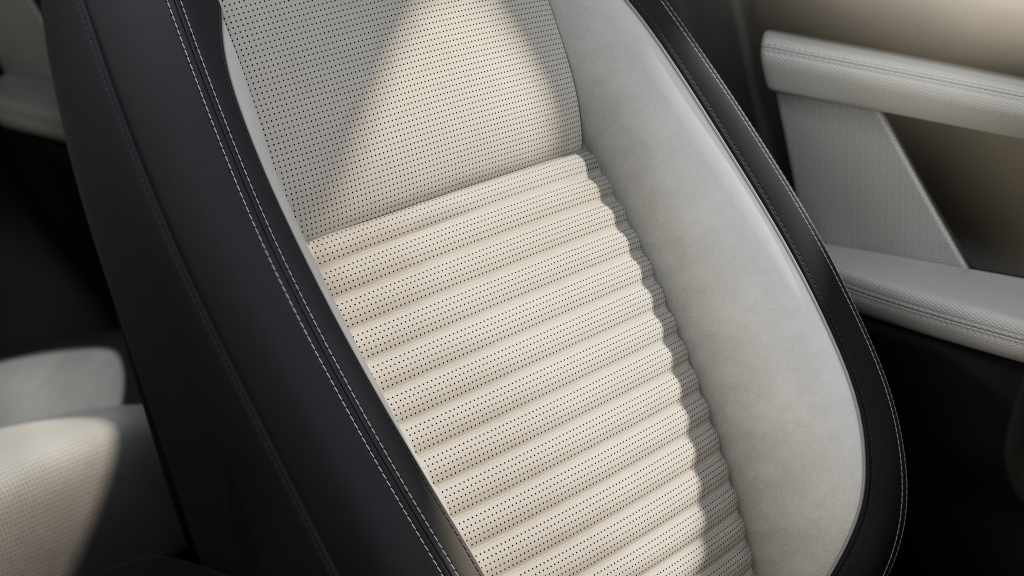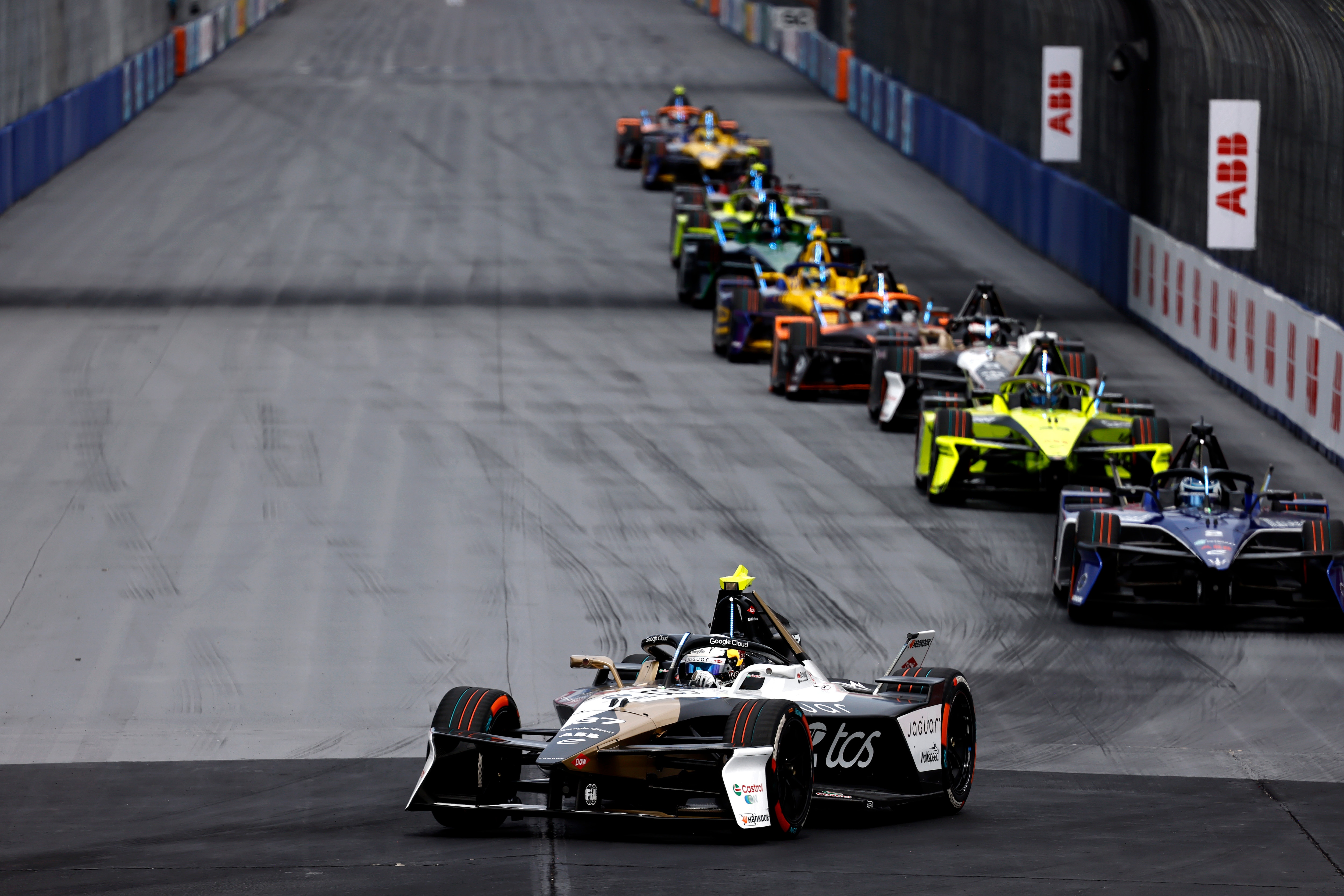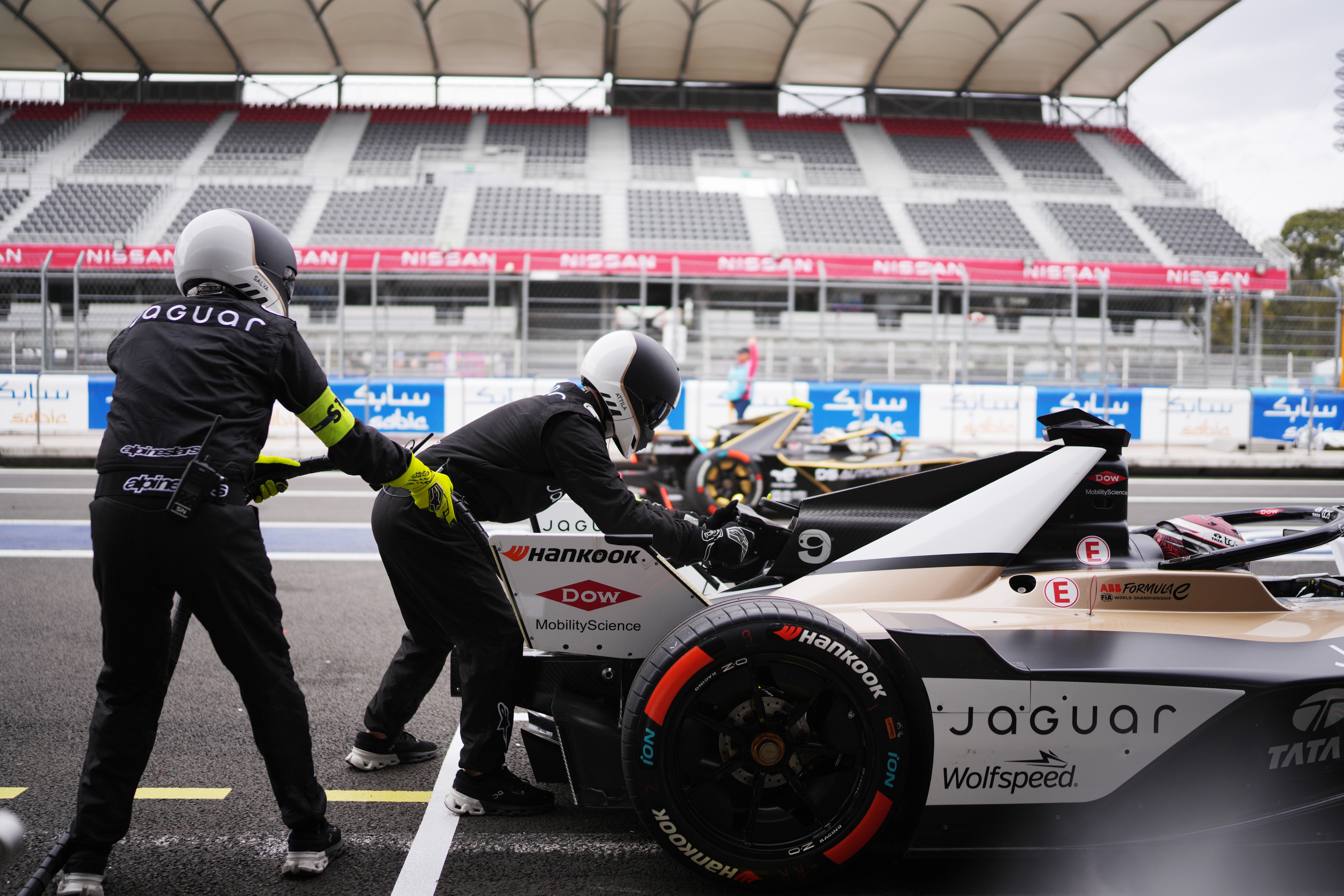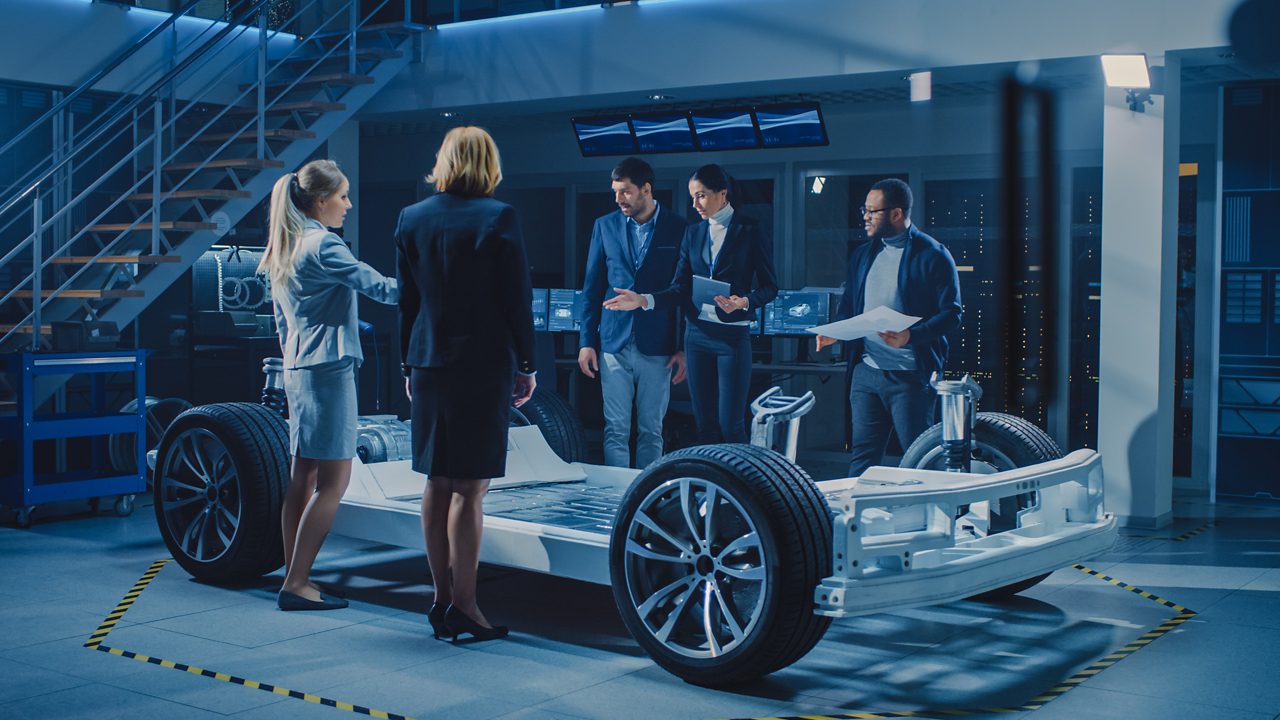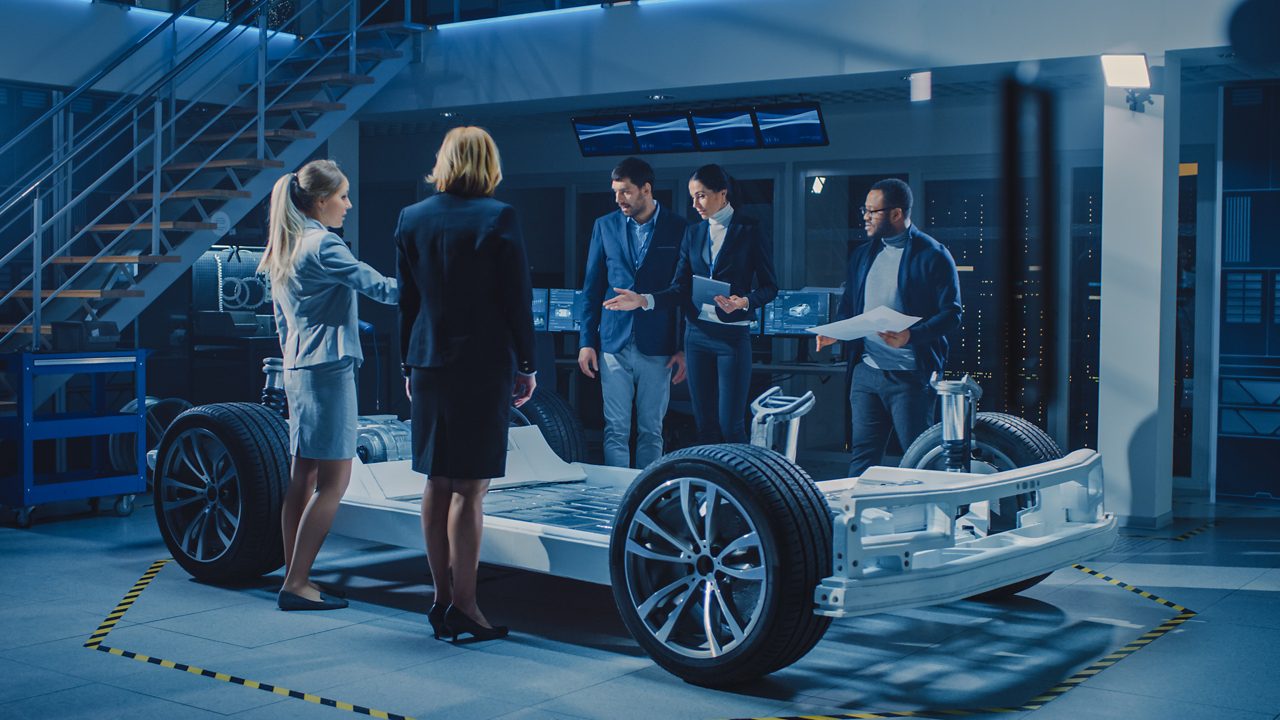
MobilityScience™
How is Dow empowering innovation through collaboration?
Partner with Dow MobilityScience to tackle material challenges. Through collaboration, we design mobility solutions that accelerate innovation.
The power and practice of collaboration
At Dow, collaboration and partnerships are critical in ensuring transformative innovation. Working in isolation will longer work in the future - we’ll move much further, and faster, together.
Collaboration with like-minded mobility partners enables us to tap into one another’s deep expertise and incorporate the latest research, processes and developing technologies to help shape the mobility of tomorrow.
Together we can help create a more sustainable, diverse, equitable and innovative future. Explore the tabs below to learn more about our key partnerships.
Partnering with JLR to Drive Circular Innovation in Automotive Seating
For Dow and JLR, Formula E is a powerful catalyst for innovation. The two brands have explored new ways to come together beyond the racetrack. Strong partnerships are built on shared visions and values, and this collaboration with JLR centers on a common goal: delivering sustainable, circular automotive solutions that prioritize performance, driven by collaboration, innovation, and inclusion. Rooted in the pursuit of low-carbon mobility, JLR is evolving into a sustainable modern luxury business with Dow by its side.
The Challenge
As the automotive industry advances toward a more sustainable future, automakers are rethinking how materials can support both performance and circularity. Jaguar Land Rover (JLR), committed to sustainable design, sought innovative materials that could deliver comfort and durability while supporting recyclability at end-of-life.
The Solution
To address JLR’s needs, Dow and Lear partnered to co-develop a new automotive seat cushion made from lighter, more sustainable materials designed for recyclability at end-of-life. The cushions, made with INFINAIR™ Polymers for Loop Technology, provide airflow, comfort, and durability while helping reduce vehicle weight and emissions. The collaboration demonstrates how industry partnerships and material innovation can accelerate progress toward more circular mobility
The Challenge
The automotive industry is in dire need of innovative options to decarbonize now. Historically, vehicles have been designed with limited consideration for circularity, challenging the industry to rethink its approach to find the technology needed to design the cars of the future. For car seating, the polyurethane foams used are difficult to recycle as they’re designed for durability, meaning they end up in landfills and can remain in the environment for several generations.
The Solution
Dow, JLR and Adient collaborated to produce new seat foam for JLR’s luxury vehicles using closed-loop recycled content, a first in the automotive industry. This breakthrough depolymerization reduces emissions, eliminates waste, and enables a secure supply of low-carbon seat foam for vehicles while maintaining the superior comfort and quality of JLR seats. By combining their expertise, these companies set a new standard in the automotive industry that advances a low-carbon future of mobility.
JLR, Adient and Dow honored by American Chemistry Council
Dow, Adient and JLR have been recognized with the External Collaborator Award as part of ACC’s 2025 Sustainability Leadership Awards. Together, the partners developed an industry-first innovation: circular seat cushions for JLR vehicles using re-polyol sourced from end-of-life vehicle foam via Dow’s Renuva™ process.
This advancement marks a major step toward sustainable mobility, with the Adient seat cushion prototypes containing 20% recycled content—cutting CO₂ emissions without compromising performance.

Advancing Circular Seating with INFINAIR™
As the automotive industry advances toward a more sustainable future, innovation plays a vital role in improving vehicle efficiency and circularity. Dow partnered with Lear, a global leader in automotive seating, to develop lightweight seat cushions using INFINAIR™ Polymers for Loop Technology, a more sustainable material designed to support recyclability at end of life. Featured in Jaguar Land Rover’s (JLR) luxury vehicles, the collaboration illustrates how material innovation and cross-industry partnerships can accelerate progress toward lower-carbon, circular mobility.

Automakers and original equipment manufacturers (OEMs) face growing pressure to reduce emissions and enhance recyclability for vehicle components such as seating systems. Public policy, including end-of-life vehicle regulations, is driving demand for materials that lower environmental impact while maintaining quality, comfort, and design flexibility. This shift requires new single-material systems that simplify recovery and support compliance with evolving circularity standards.
To meet these challenges, Dow’s MobilityScience™ team collaborated with Lear to apply INFINAIR™ Polymers for Loop Technology within Lear’s FlexAir seating systems. The 3D loop structure, made from thermoplastic elastomer filaments, delivers airflow, comfort, and durability while supporting recyclability at end of life.
Validated through Dow’s Pack Studios, the material was optimized for performance and sustainability, helping, according to Lear, reduce CO₂e emissions by up to 50% and seat assembly weight by up to 20%. This partnership demonstrates how advanced material design enables automakers to align with policy expectations for circularity and carbon reduction without compromising passenger comfort or aesthetics.
Partnering with Jaguar TCS Racing on EV Thermal Management
The ABB FIA Formula E World Championship is a groundbreaking single-seater motorsport competition for only electric cars. Alongside our partners at Jaguar TCS Racing, we are accelerating material development in real time by introducing a range of technologies that advance safety, comfort, range, and low-carbon solutions for automobiles, on and off the track.
Among the primary challenges of maximizing EV performance is perfecting thermal management, from enhanced utilization of waste heat to more optimized cooling of key components. This is especially true for Jaguar TCS Racing’s I-TYPE 6 race car where the car is being pushed to the absolute limit.
As the Official Materials Science Partner of Jaguar TCS Racing, Dow’s MobilityScience™ engineers came alongside the racing team to identify key challenges to racecar performance, safety and efficiency, and determine the materials that may solve them. In the case of thermal management, this consisted of understanding their unique requirements and existing limitations.
In a relatively short time, Dow was able to help the team determine the thermal interface material that provided the greatest optimized performance in not just thermal conductivity, but resistance and durability too. Dow’s solution also helped protect and regulate necessary components in the crucial powertrain, despite each component having its own preferred environment and temperature.
Watch to learn more about the importance of thermal management with JLR Motorsport’s Research and Innovation Manager, Jack Lambert.
Discover more about MobilityScience™ and Jaguar TCS Racing

Dow announces partnership extension with Jaguar TCS Racing at 2024 Tokyo E-Prix, reinforcing its commitment to sustainable mobility.

Partnership leaders speak with The Sustainability Report on why their collaboration around innovation and sustainability is so productive.

On this episode of the Seek Together Podcast, hear what Dow and Jaguar TCS Racing leaders believe the future of mobility holds.

Through our collaboration with Jaguar TCS Racing on the Formula E circuit, Dow is using the power of materials science to advance the mobility industry.
Partnering with Bridgestone to develop recyclable tire sealant technology
When collaboration leads to the creation of a first-to-market technology that also supports a more sustainable future, it is truly something special.
Dow introduced the world's first silicone-based self-sealing tire material – an innovation developed in partnership with Bridgestone, a global leader in tires and rubber. This high-performance technology marks an acceleration in the companies’ joint journey toward carbon neutrality.
Roughly one-third of all new passenger vehicles sold in the U.S. today are no longer equipped with a spare tire due to increased demand and availability of extended mobility solutions such as self-sealing and run-flat tire technologies. Unfortunately, most of the existing conventional sealant materials are difficult to separate from tires, which compromises tire repairability, end-of-life tire recycling, and tire material circularity.
After more than four years of joint research and development, in June 2022 Bridgestone introduced B-SEALS, the first-ever extended mobility self-sealing tire solution that can be easily recycled at end of life. This breakthrough technology - using newly developed SILASTIC™ self-sealing silicone material - provides excellent sealant performance in the event of a puncture without compromising sustainability.
B-SEALS sealant can be efficiently separated from tires to promote tire repairability and potentially extends the amount of time a tire is in service.
Bridgestone will initially offer tires with B-SEALS sealant technology to OEMs looking to reduce vehicle weight and improve overall efficiency as more electric vehicles come to market.
Partnering with HiPhi to develop sustainable silicone leather seating
The leather industry market is being reshaped by the demand for environmental protection and sustainability.
Genuine leathers are luxurious with excellent hand-feel, but they are increasingly rejected by customers demanding animal-free products while synthetic leathers made from polyurethanes, polyvinylchlorides and silicone are often inferior alternatives.
LuxSense™ is a silicone-organic hybrid synthetic leather that combines the benefits of both to become the first synthetic leather that competes with authentic leather.
Innovative Chinese automotive startup HiPhi approached Dow Mobility’s team in China in 2019 about developing a revolutionary high-end, sustainable synthetic leather material for seats. They wanted it to match or exceed the finest Nappa leather in terms of touch, appearance, and experience without use of volatile solvents and plasticizers. Ultimately, they wanted a luxurious, odorless, low-carbon, environmentally friendly material for their first luxury electric SUV vehicle, the HiPhi X, launched in 2021.

MobilityScience™
LuxSense™ Silicone Synthetic Leather material meets specifications in mobility interiors, as well as other consumer applications. It delivers a luxurious sense of sight in terms of cleanliness, durability, color personalization and design freedom. LuxSense™ also avoids DMF and plasticizer usage, providing enhanced sustainability, as well as superior UV resistance and hydrolysis resistance that effectively prevents leather aging.
High flame retardancy is coupled with self-extinguishable features, and no harmful gasses are released in the event of a fire, making it a safe option for use in confined spaces. LuxSense™ adopts the innovative top coating technique to ensure fresh and non-tacky touch even in humid environments.
This low-carbon synthetic leather uses a green fabrication process, contributes to animal welfare, and meets customers’ social responsibility.
LuxSense™ is odorless and low VOC, meeting auto regulation. The liquid silicone rubber technology avoids DMF and plasticizer usage.
Soft touch and skin-friendly, this non-tacky surface creates a more comfortable experience for customers in vehicles, yachts, and aviation.
Partnering with NASCAR’s Richard Childress Racing
In NASCAR, a driver’s car should be fast, but it also needs to be safe and reliable - and that’s where Dow comes in. Through prototype development, data analysis and experimentation, Dow and Richard Childress Racing’s (RCR) collaboration has maximized performance on and off the racetrack.
Watch to hear from driver Austin Dillon and the RCR team how our understanding of materials science is helping their vehicle cross the line faster, stronger, and first.
Bringing a concept to life that encapsulates the need for speed, performance, safety and innovation is no small feat – but with Dow, it’s possible. Richard Childress Racing approached Dow on Monday morning after a weekend race – the tire rubber of the No. 3 Dow Chevrolet was sticking to the wheel, slowing them down. They were hoping for a solution to prepare them for the following Sunday, so Dow got to work.
Our partnership with Richard Childress Racing (RCR) goes beyond the Diamond on the hood of the car, and much further than the finish line. Collaboration is at Dow’s core and allows us to utilize the power of materials science to advance the mobility industry. Together, scientists and engineers from RCR and our Materials Engineering Center (MEC) develop, test, and apply innovative technology ready for the racetrack to help increase performance and safety of the No. 3 Dow Chevrolet.
In a relatively short time, Dow helped the team with a quick fix for the sticking rubber and, with RCR, found a silicone mold release gel as a long-term solution. Under significant pressure and speed, value must be added safely and competitively. This silicone mold release gel works by creating a barrier between the wheel and any rubber flung up from the tires and track during the race. Keeping the tire rubber from sticking to the wheel maintains the wheel’s light weight design and prevents undesirable imbalance effects.
No matter the need, Dow’s MEC team brings extensive engineering knowledge and expertise to every unique task.

Honoring U.S. Military Veterans
For nine years, Dow has honored the sacrifices of U.S. Veterans and their families by partnering with NASCAR’s Richard Childress Racing. The program began in 2015 with just over 350 veterans honored on the hood of the No. 3 Chevrolet and has grown to more than 2,100 this year.
This initiative is coordinated by one of Dow’s many Employee Resource Groups, Veterans Network (VETNET).
Partnering with Hella to develop the future of automotive lighting
For years, the conventional approach to automotive LED headlamp design relied on mechanical actuators to position the beams of a single, controllable LED row. Hella KGaA Hueck & Co., a leading manufacturer of innovative automotive lighting components, envisioned a more dynamically adaptive solution that needn’t rely on mechatronic components.
Hella’s search for a solution led to Dow, where they explored several grades from the award-winning moldable optical silicones product family.

Incorporating 84 individually controllable LED pixels arrayed in three rows, the headlight dynamically distributes light in real time based on changing traffic, weather, and road conditions. It also enables the high beam function to be used more frequently to provide greater safety. Distributing light evenly from the module’s 84 LEDs required design of a complicated primary lens structure incorporating 84 light guides. The primary lens material needed to be highly flexible and durable to perform reliably during long exposure to high temperatures and photodensities.
With assistance from MobilityScience™ experts, Hella eventually specified SILASTIC™ MS-1002 Moldable Silicone which, exhibiting 72 Shore A, delivered the most suitable combination of hardness and elongation to produce complex lenses. This highly transparent material processes easily at room temperature and exhibits very low viscosity before cure. Combined with its high elongation and tear strength and easy demolding performance, these qualities significantly expand design possibilities for fabrication of complex shapes, micro-scale optical structures, multifunctional parts, and undercuts that are difficult to achieve with organic polymers. The outstanding thermal stability of SILASTIC™ MS-1002 Moldable Silicone was the most critical attribute.
Questions about Dow Mobility products and capability? Get in touch with a representative.
Hear from Dow with our latest innovations and news as we accelerate towards a more resilient, low-carbon future.

